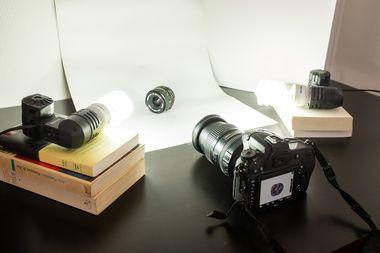
How to take product photos without a studio and with a minimum of equipment?< /h2>
Taking quality photographs at home and with a minimum of equipment remains accessible for a large number of photographers. Deco...

5
What better than a beautiful photo to increase your chances of selling your creations or your objects and other second-hand clothes. We offer you a guide to obtain a quality result with few means.
Online commerce is accessible to everyone, whether you are a creator who wants to sell his products on Etsy or a simple individual who is looking to sell second-hand items on Le Bon Coin or on eBay. But to achieve this, the presentation of the objects is important, perhaps well beyond the price, since it helps to arouse interest and inspire confidence and professionalism.
In appearance, the packshot type photo may seem inaccessible and require expensive equipment. In reality, it is quite possible to approach a professional rendering with everyday objects, an entry-level camera or with a smartphone! If you follow the practice of "do it yourself" (or "do it yourself" in French), it is even possible to develop your creativity.
We propose in this tutorial to make your images without spending a fortune. Although our advice remains valid for selling clothes on Vinted or La Reboucle, the presentation of large objects still responds to a few different and specific constraints.

However, it is entirely possible to adapt our recommendations to your needs according to the type of product (jewellery, clothing, high-tech products, etc.) and your own creative ambitions. Now let's get down to business!
But before getting to the preparation, let's recap the main tools needed:
First of all, you have to tidy up the room where the photo session will take place. When taking photos, working in a cluttered environment is often a problem. You have to make room. Pets are also to be banned to avoid dust and hair. An accident like our friends the cats like to cause also happens quickly. Similarly, clean the objects of dust and fingerprints. This point should not be overlooked and lightens a possible post-production phase.
To create the background of our image, we must place a table against a wall. Next, we use a large sheet of paper. For the most neutral background possible, the sheet must be white, but it is also possible to use colored sheets. Large format sheets are easily found in stationery or on an online store. Prefer a heavy weight for better resistance.
Then, you have to fix the sheet on the table, which is itself pushed against the wall. Be sure to leave a nice curve on the joint between the wall and the table. So that the sheet does not move; clips, tape, or a weight like a heavy book can be used.
Ideally, for a packshot, you need three light sources:
Of course, all this can be adapted according to your means, the equipment and the number of lights you have.
If you don't have any usable light source at hand, you can always try shooting with daylight. If this solution is possible, it is perhaps a little less easy to master. Indeed, you have to deal with several constraints, such as the location of the photograph, the weather or the time of day. Anyway, we have also dedicated a tutorial to this practice. Rather oriented for a realization with a dedicated camera, the recommendations obviously remain valid for a smartphone.
Taking quality photographs at home and with a minimum of equipment remains accessible for a large number of photographers. Deco...
As soon as a light source is missing, it is possible to compensate for it by installing a reflector. Placed opposite the light source, the reflector will, as its name suggests, reflect the light and clear the shadows cast. Conversely, if your key-light is too strong, it can overexpose your photo or create excessive shadows. Using a diffuser makes it possible to attenuate the flow of light.
To take the shot, we need to use the smartphone or the camera in its manual mode. The latter is often called “pro” on smartphones. The absence of such a mode is not a problem if your installation is rigorous.
For convenience, using an automatic or semi-automatic mode may be sufficient. If your smartphone does not have a "pro" or "manual" mode, this will not prevent you from obtaining good results if your installation is carried out correctly.
After a few tries, if a setting is suitable, you can change the position of the object to photograph it from all angles. In this case, take care not to move or disturb your installation and reposition the object on the original location.
If you have cleaned your object well and managed your preparation well, there will be almost nothing to do in editing. On a photo editing software or application, even basic and free, mainly adjust the exposure and the highlights to avoid a dull image and to find really white whites.
Adjusting the shadows compensates for the effects of absent or too powerful light sources. The contrast gives relief to the image and the saturation revives the colors. Be careful not to have a heavy hand at the risk of obtaining an unattractive and too artificial rendering.
Of course, investing in a fully equipped studio or in accessories allows you to obtain tailor-made results of excellent quality. Despite everything, a simple smartphone or a camera already gives very good results without investing large sums. With a little trick, the means at hand, and above all several tries, taking attractive and successful photos for your customers is within everyone's reach.